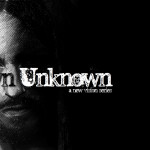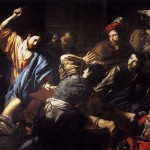I happened upon AMC’s Zombie series, the Walking Dead while surfing Netflix a few months ago. Interested, I tuned into the first episode.
A patrol car arrives at an accident. A cop draws his gun and steps from the car. Someone or something is out there.
As he walks towards the wreck, the camera pans revealing a more apocalyptic scene – a street and gas station choked with abandoned cars. He windes his way passed the accident and cautiously enters the jumbled maze.
The cop spins.
An eight year girl holding a teddy bear stands before him. Her face is bruised and her mouth bloody. He hesitates with gun raised. Might she be an accident survivor?
She moves towards him stiffly and hisses.
He fires.
The zomebie-girl, struck in the head, falls back in slow motion.
I decided to watch something else.
Zombie’s in Pop Culture
You’d have to be – well a zombie – not to realize zombie’s are everywhere today. No there aren’t actual zombies walking among us – OK that might be a matter of opinion – but the number of zombie references in pop culture is certainly on the rise. Just compare the quantity of zombie video games, films and novels produced over the last 12 years with the number prior to 2000.
Zombie’s have infiltrated almost every area of culture. With the ZombieBooth App for instance you can turn your mug into a decomposing corpse. Or if sitting around on your phone isn’t for you, You can now motivate yourself to get in shape with a 5K zombie survival run.
Even FEMA and the CDC are using zombie’s to hype disaster preparedness.
A recent string of crazed drug-induced actions, some involving canabalism, have been dubbed “zombie attacks” by the media. Some people are not messing around. The manufacturing and purchasing of Zombie bullets is now on the rise.
Why Zombies? Why Now?
I recently asked my friends on Facebook why they thought there were so many cultural references to zombie’s today. One replied back “We’re tired of Twilight.” It’s funny because it’s true.
I think we might find the more immediate cause in the success of the Resident Evil franchise in the late 1990’s and the reinvention of the pathetically slow zombie with more immediate cause is the success in the late nineties of Resident Evil franchise and . popularity of Zombie’s stems from three places. Resident Evil, 28 days later and twilight.
Frankly I think there is a bit of truth in that. The undead have certainly made a come pack since Stephanie Meyer wrote here book.
Monsters are more than monsters. Monsters represent things. Stephanie Meyer understood this when she wrote the Twilight series (no I have not read the books but I have seen a few of the movies). There’s a certain sexuality to Vampires that while not explicit is definitely there. Vampires are completely in control of themselves. They typically are well dressed men who are invited in by woman. Vampires never force themselves upon woman but woman eventually give into the neck bite (which is by the way is a bite on the upper leg in some cultures) and exchange fluid. Stephenie Meyer took the stereotype of a vampire and reversed it, making a “teenage” vampire a vegetarian and a person who chooses resist human blood. The apple of the cover is not without a deep symbolic significance. It is the forbidden fruit. True Blood on the other hand has taken the implicit symbolism in the vampire to the other extreme. What would you expect from HBO? The blood of a vampire is the strongest of aphrodisiacs. I’ll so no more.
What do Zombie’s Represent
Zombie’s come from Hati – they are mindless puppets of a hodoo witch. They were first popularized in film in the universal monster craze of the 1930’s along with Vampires, Frankenstein and the warewolves. They were characterized by being the unconscious – mindless – puppet of a master.
The image of Zombie’s however changed with the advent of George Romero’s film The Night of the Living Dead in 1969. While still the mindless creatures Hatian lore and earlier films, Romero mixed his Zombie’s with elements of vampires and warewolfes. Like Zombies before they existed in-between life and death. But they feed like werewolves and like Vampires they spread Zombisim through a bite.
The Zombie’s of NIGHT, however, remained fully human. Apart from being reanimated dead, they had none of the supernatural strength of a Warewolf or a Vampire. They were frail. They’re only strength was in numbers. The film made plane that Zombie’s were a representation of us. Our enemy was not some other wordily menace but the tide of inhumanity that surround us.
The Zombie’s of Romero’s films is what we typically find in pop culture today. Films depicting Zombies typically exhibit a small contingent of conscious humans fending off the overwhelming tide of inhumanity around them. While the Zombie’s attempt to feed on the conscious humans, the conscious humans both fight against being eaten and or having there consciousness stolen by the blood or bite of the Zombie.
Zombie’s represent (Here is a reference to earlier article
- The Fear of Death – Vampires may be dead but they never look like the rotting corpses that Zombies do. In that Zombie’s terrify because they remind us of the decomposition that awaits our own bodies in the grave. To see a departed love one appear at your doorstep in all the gory detail of the present state would be a shock beyond all shocks.
- The Fear of Widespread Apocalyptic Destruction – Zombie films almost always have an overwhelming number that have either been effected by nuclear radiation or a plague. Night of the Living Dead represented the terrors of the cold war and Black ops which is Medal of Honor’s answer to the Cold War has Nazi Zombies. – plays into that cold war fear. Today, we seem to be more afraid of universal plague than nuclear radiation. David Mccormiks book, though it doesn’t have any Zombies reveals the ways that even rational human beings can act like Zombies when it comes down to simple survival.
To these I want to add the fear we have of each other. The fear we have that humanity is slowly losing its humanity. That the barbarian is at the gate. He’s in my next door neighbors house. He is my neighbor. The more we attach ourselves to computers and video games. The more we cease to talk to the person next door. The more we sit on our phone in the line at the grocery store instead of engaging with the people around us. The more we begin to suspect that other people are inhuman. That they are less than us. We dehumanize the next. Their not human their Zombies and thinking of people as Zombies makes us a little less likely to kill them.
The scene at the beginning of Walking Dead disturbed me because it makes us a Zombie to watch such things. We’ve become calloused to the needs of humans around us. We live as if we’re the only conscious people left.
In the Last Days the love of most will grow cold.
I know it may sound strange but we don’t fight against the Zombie by killing Zombie we destroy the Zombie is us by caring for the Zombie.























